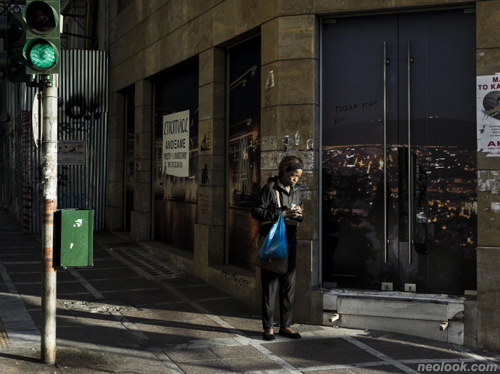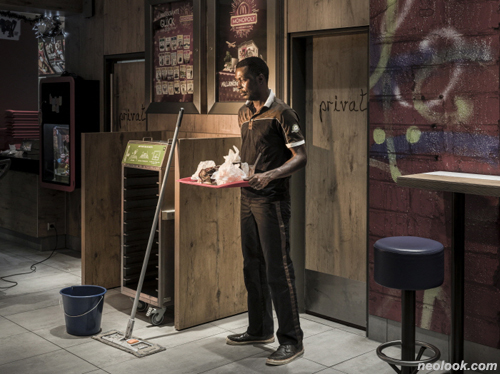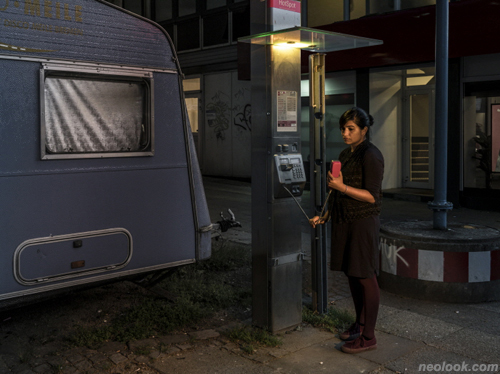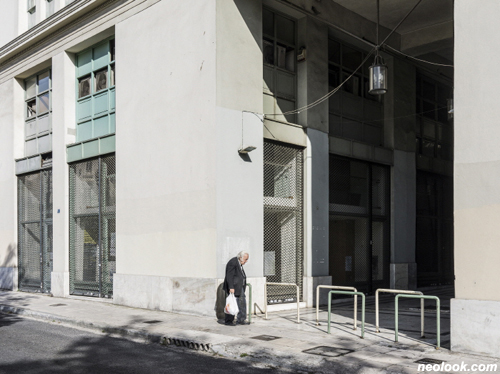- ● homepage
- ● archives
- ● restoration
- ● books
- ● big banners
- ● post board
- ■ neo's search
- ■ about us
- ■ 게재방법 안내
- 개인정보처리방침

- [email protected]
- Tel. 02_335_7922
- Fax. 02_335_7929
- 10:00am~04:30pm
- 월요일~금요일
- 3/3(월) 대체공휴일

It's not your fault
이재욱展 / LEEJAEUK / 李宰旭 / photography 2018_0809 ▶ 2018_0909
● 위 이미지를 클릭하면 이재욱 홈페이지로 갑니다.
초대일시 / 2018_0809_목요일_06:00pm
제10회 KT&G 상상마당 한국사진가 지원 프로그램(KT&G SKOPF) 올해의 최종작가展
관람시간 / 11:00am~08:00pm
KT&G 상상마당 갤러리 KT&G SANGSANGMADANG GALLERY 서울 마포구 어울마당로 65(서교동 367-5번지) 5층 Tel. +82.(0)2.330.6229 www.sangsangmadang.com
불온함에 대하여 ● 한 사람의 작가는 어떤 방식으로 사회와 삶을 바라볼 수 있을까? 그리고 이를 어떤 방식으로 물리적 형태의 결과물, 즉 작품으로 남겨 놓을까? 이재욱은 이 질문에 대하여 동시대 미술계에 섬세한 층위 하나를 덧입히는 잠재력을 가진 작가라 할 수 있다. ● 이번 전시에서 선보이는 그의 작품은 사회와 삶을 바라보는 작가의 균형 감각과 새로운 감수성을 제안한다는 점에서, 유사한 주제를 다룬 여타의 작품과 또 다른 방식을 보여 준다. 사실 이번 작품에서 표현한 재개발, 사회 부조리와 개별자, 비극의 역사는 한국 현대미술에서 다양한 작가들이 해석해 온 주제다. 그래서 자칫 익숙한 테마라고 생각할 수도 있지만, 그의 작품은 그 너머, 물리적 형태를 넘어선 일상에 도사리고 있는, 인지하지 못하는 인지의 속성을 다룸으로써 그들과 변별력을 구축한다. ● 즉 이재욱의 작품에서 보이는 일상은 나른한 '불온함'을 머금고 있다. 그리고 이들의 모습을 바라보는 우리는 세상을 담아내는 모니터를 통해 여러 지역을 순회하는 듯한 느낌을 받는다. 초기 작품에 나타난 재개발 지구의 단면은 실제 미술계에서 다뤄 온 사회 비판의 시각과 차이가 있다. 실제 작가가 성장한 일상 공간으로서 재개발 지역은 평온함, 보편성 그리고 그 층위 아래 생존에 대한 위협감이 배어든 채 포착되어 있다.

- 이재욱_behind the mythology #2_디지털 프린트_2016
이는 『It's not your fault』에서 좀 더 넓은 세계로 확장되었다. 작가는 하나의 주제를 중심으로 유럽과 몇몇 아시아 지역을 선택하고, 이를 통해 '국가'라는 범주화된 선택 공간을 중심으로 사진 찍기를 시도한다. 일정한 문화, 경제 지역과 특정 영토 안에 구성된 사람들이 살아가는 일상의 한 부분을 다루는 것이다. 이들에게 국가는 일상에서 가시적으로 존재하는 것이 아니다. 사실 최고 통치권을 가진 국가는 자국민의 사회적 목표와 욕구를 제도를 통해 효율적으로 실현해야 하지만, 복잡한 국제 관계, 자본과 경제의 이동, 인종, 계층 등 많은 갈등으로 인해 제대로 작동되지 않는다. 그리고 그것은 개개인의 삶에 영향을 미친다. ● 이때 작가가 들여다본 국가는 크게 네 개 지역이다. 바로 터키, 독일, 그리스, 한국인데 이들 지역의 공통점은 경제 파탄, 테러, 인종 차별, 민주화 등의 문제로 인해 사회적으로 커다란 위기와 갈등 상황을 겪으며 국제 사회의 주목을 끌었다는 것이다. 그중에서 독일과 한국은 작가의 생활 기반이며 일상의 삶과 밀접하다는 점을 감안한다면 오히려 이 주제에 대한 고민이 추상적인 것이 아니라 내밀한 개인성에 근거한다는 점이 신뢰를 얻는다. 독일의 경우는 난민 문제와 테러에 직면한 유럽의 상황을 잘 보여 주는데, 사실 이러한 부분은 개인의 문제뿐만 아니라 이 안에서 복잡하게 움직이는 부의 불평등, 편견을 기반으로 한 인종 차별 등의 이데올로기 문제 등이 얽혀 있다. 그러므로 이러한 위기는 불안 딜레마를 야기하며, 사회 구성원들의 분열을 불러일으킨다. 개인은 이유를 알 수 없는 불황과 고통에 일상을 잠식당하고 마는 것이다.

- 이재욱_inner safety #3_디지털 프린트_2016
이재욱은 이러한 대전제들로 인해 관계가 균열을 일으킬 때 맞이할 수밖에 없는 개인들의 무력함과 정서에 관심을 두고 있다. 한국에 대한 작업 역시 지난 촛불시위의 결과와 별개로 여전히 거리에서 벌어지는 세대 간 혹은 정치적 대립 상황을 다룬 것이다. 여기에서도 작가는 사건의 원인이나 결과, 상황보다는 그로 인해 드러나는 개인의 모습에 집중한다. 이 경우 기존에는 개인을 투사나 피해자로 묘사했다. 그러나 극단적 분열 상황인 시위 장면에서도 이재욱이 포착한 것은 한 귀퉁이에서 태극기를 내린 무기력한 모습들이다. 작가는 이를 통해 개개인이 모여 거대한 집단 정체성으로 표기되는 어느 영토의 주인인 국민이 마주하는 현실은, 사실은 그들이 주인이라는 권리를 인정하는 국가가 만들어 내는 불온한 위기라는 것을 말한다. 또한 이 때문에 개개인은 매우 무기력한 존재로 전락함을 보여 준다. 그러므로 '당신의 잘못이 아니다'라고 말하는 것은 어쩌면 진실한 말 걸기이며 본질을 언급하는 표제어일 것이다. ● 이 시리즈를 담아내는 이재욱의 작품 촬영 방식은 순간을 잡아내는 스냅 샷이지만, 마치 설치 작업 같은 진행으로 긴 시간의 계획 아래 이루어진다. 오랜 시간을 들여 작가가 덫처럼 설치해 둔 장소에 실제 그곳 상황에 엮여 있는 사람들의 모습이 포착되는 것이다. 그리고 그들의 실제 표정을 잡아내기 위하여 무선 릴리즈를 통해 카메라에 담아내는 방식을 이용한다. 그 결과 그들의 표정은 비현실적으로 느껴질 만큼 나른한 무력함을 보이지만, 사실은 매우 현실적인 모습이라는 모순을 실현한다. 다만 풍경 사진과 인물 사진의 병치는 증폭되어야 할 시너지 효과가 이미지와 내러티브에서 강한 긴장감을 도출하고 이를 통해 더 강렬한 시각적 공감대를 형성할 수 있을지 좀 더 지켜봐야 할 과제이기도 하다.

- 이재욱_inner safety #4_디지털 프린트_2016
최근 작품인 '한계선'에서 작가는 이 '불온성'에 대해 좀 더 선명하고 날카롭게 시각화하는 방식을 찾아냄으로써 스스로 그 해답을 찾아가고 있다. 제주 레지던시 프로그램에 참여하며 제주 4·3사건을 접한 이재욱은 '불온성'을 한국 역사의 구체적인 대상과 장소로 확장했다. 이는 기존의 '현상' 중심의 해석과 표현이 더 깊이 있는 주제로 확장되었을 뿐만 아니라 표현 방식에서도 주관적인 시선이 더 개입된 것으로 읽힌다. 이 시리즈는 그동안 모호하게 표현해 온 '볼온성'을 물리적 형태로 직접 가시화했다는 점이 가장 큰 특징이다. 생사의 극단적 기준인 '해안선에서 5킬로미터'라는 기준을 붉은 레이저를 설치하여 한밤에 장노출로 촬영한 것이다. 작가는 촬영을 위해 스스로 만든 이 선조차도 넘어서기 힘들었음을 고백하며, 검열과 억압의 선은 사회와 개인 안에 아직도 존재함을 증언한다. 그는 보이지 않는 '불온함'을 보이게 함으로써 일상에 스며든 국가의 극단적 폭력을 확인 가능한 그 무엇으로 만들어 낸 것이다. 기존 작품에서 고민하던 일상의 평온함에 도사린 '불온함'을 구호의 도움을 빌리지 않고도 오직 화면에 등장하는 이미지 간의 긴장감을 통하여 좀 더 시각적인 공감대를 형성해야 하는 과제에 한발 더 다가선 모습이라 할 수 있을 것이다. 작가는 균형과 감수성이 내재된 작품 창작이 이방인처럼 맴도는 자신의 내성적 성향이라고 말한다. 하지만 원래 예술가는 어느 시대 어느 사회에서도 이방인으로 존재하며 작품으로 그 시대를 영원히 증언한다. 이재욱은 이를 그저 진솔하게 실천하기 때문에 가능한 것 같다. ■ 강수정

- 이재욱_inner safety #6_디지털 프린트_2016

- 이재욱_what remains #10_디지털 프린트_2017
About Restlessness ● In what ways can an artist view the society and life? How will the person transform them into a concrete product, or to simply put it, a piece of art? Jaeuk Lee is an artist who answers these questions with his talent that adds a delicate layer to the contemporary art scene. Lee's recent artworks take a different approach from other works that share a similar theme, by displaying new sentiments and artist's balanced views on society and life. In fact those reconstruction sites, social injustices and their particulars, and history of tragedy he has expressed in the images are themes already dealt by many Korean artists. Thus at a glance they may seem familiar, but unlike others Lee's works discuss the unrecognizable nature of awareness that are hidden in everyday life beyond the physical forms. Ordinary life in Lee's artwork shows weary restlessness. By gazing at it, we feel as if we are traveling to different places around the world through the frame. Scenes of reconstruction from his early works differ from the criticism on society made by the actual art world. He captures this place where he actually grew up in as calm and common, but beneath all of them it is colored with survival-threatening intimidation. The images expanded into a wider world in It's Not Your Fault. While focusing on one theme, he had chosen different areas from Europe and Asia. Through them he attempted to photograph the selected spaces categorized as a nation. He looked into a part of people's daily lives made within certain boundaries of culture, economy and territory. To those people country is not visible in day to day life In fact as a holder of the strongest sovereign power, a nation should effectively execute social goals and realize its people's desires through the system. But often the system does not function properly due to complex international relations, movement of the capital and economy, and conflicts caused by race and social class. The result influences the lives of individuals. The artist looked into mainly 4 regions: Turkey, Germany, Greece and Korea. All of the areas made international news when they went through intense social crisis and conflicts caused by economic turmoil, terror attacks, racism and democratization. Since Germany and Korea are home to the artist and closely related to his daily life, it becomes more evident that his thoughts on the theme are not abstract but are private and personal. The case of Germany highlights Europe's current status facing the refugee issue and terrorism. In truth not only are these points related to him personally, but inside they are also intertwined with ideologies such as inequality of wealth that maneuvers complicatedly and prejudiced-based racism. Therefore such crisis results in anxious dilemmas tearing apart members of the society. The lives of individuals then become overwhelmed with uncertain depression and pain. Due to such sumption Lee is interested in helplessness and other sentiments individuals bound to feel when such macro conditions cause relationships to deteriorate. His project in Korea discusses the on-going confrontations between generations or different political powers still witnessed in the streets, regardless of the outcome from the past candle light protests. Once again, instead of causes, results, or circumstances of events, the artist concentrates on the faces of individuals exposed by these elements. In such cases the individual had been described as a fighter or a victim in the past. Yet even in an intense moment of protest, Lee captures the helpless looks on people standing in the corner with their flags lowered. From these images the artist speaks of the reality faced by the people, who are the owners of certain territory marked by a great group identity collectively created by individuals; that the truth is a restless crisis generated by the nation admitting the rights of people as its owner. It also shows because of this, individuals become utterly helpless. Therefore to say 'it's not your fault' is perhaps an honest dialogue and a headline marking the essence. Photographic methods Jaeuk Lee chose for this series include pseudo documentary and stra snap shots to capture the moment. Both methods resemble an installation project and are conducted after long hours of preparation. The artist took time to install trap-like cameras in different locations and people who are actually part of incidents occurring at those places were photographed. In order to catch their real expressions on camera he used a wire-less release device. As a result, their expressions are so wearily helpless that they are bordering on surreal. Ironically they are very realistic. Even so it remains to be seen whether layering landscape with portrait can enhance their synergy and create strong tensions in the image and narrative to form stronger visual consensus. In his most recent series titled Red Line, the artist finds an answer on his own as he discovers a way to visualize this restlessness more vividly and sharply. During his days at the Jeju Residency program, he came across Jeju's April 3rd Uprising. From there he expanded the restlessness to a specific subject and location from Korean history. His interpretation and expression that once focused on phenomenon expanded to intensified themes. His description too shifted to be more subjective. The most significant part of this series is that the restlessness he had previously expressed ambiguously were visualized in direct physical forms. 5 kilometers from the shore was an extreme condition to decide life and death. He used long exposure to capture the line drawn in nighttime with red laser light. He confesses he himself had trouble crossing the line during the shooting, admitting the line of censorship and oppression still exist in society and individuals. By visualizing the invisible restlessness, he took the extreme violence of a nation that had penetrated into daily life and transformed it to something tangible. He has taken a step closure to his goal of forming a more visual agreement on the restlessness found in everyday life by only using tension between images on screen without the help of any slogans. Lee explains his creations filled with balance and sentiments are about his inner tendency to hover like an outsider. Nevertheless, artists are people who have always existed as an outsider to eternally testify the era with their art. Lee makes it all possible because he simply acts with honesty. ■ Soojung Kang
Vol.20180809a | 이재욱展 / LEEJAEUK / 李宰旭 / photography

